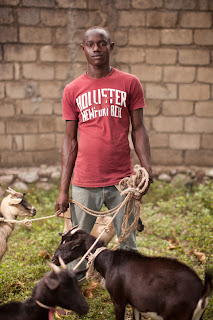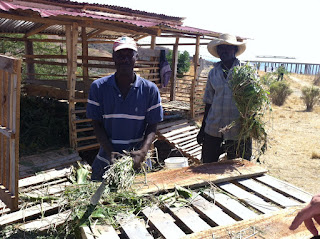Heifer's Vice President of the Americas Program Oscar Castaneda is traveling in Haiti with CEO Pierre Ferrari. They have been visiting communities participating in Heifer's Rural Entrepreneurs for Agricultural Cooperation (REACH) Project. Here is another account from Oscar.
History in Haiti tells of people moving from slavery into freedom, only to slip back into a different type of chains–harder to break, overbearing and longer-lasting–stronger, external and never-ending debt. The countryside with lush forests and productive lands became exposed hills and degraded soils. But the spirit of the Haitian people remains unbroken; Haitians are ready to work, happy to join and willing to support each other.
 |
Celiot Charles and his goats.
Photo by Dave Anderson,
courtesy of Heifer International. |
In isolated communities, change is happening. The recipe has basic ingredients: a family, a community organization, a committed supporter, hard work and a goat.
Celiot Charles from the community of Maniche received a module of four goats from Heifer, and he hopes to do as well by his neighbor. A goat will eat anything green and transform it into meat, manure, material, muscle, milk, money and a lot of motivation (all of Heifer's 7 Ms). One goat is worth $75 and buys education for children, uniforms for school, and doctor's visits and medicine. A goat is the best piggy bank in Maniche, Degand, Montrouise, Ivwa and many more villages in Haiti.
 |
| Project participants chop grass for goat fodder. |
The true value of a goat goes way beyond $75, though; it has the potential to connect many additional links that a family in need would not normally have access to. Without support, poor families are often desperate, in a hurry and need money right away. Through Heifer's REACH project, organizing goat production and adding feed production, processing and collective selling in the local markets, the added value of the goat stays in the community.
 |
| Goat breeding center in Degand. |
In Degand, the brand new goat breeding center has the potential to generate up to $10,000 a year, which will pay for school teachers and improvements to the local school. This goat breeding center is social entrepreneurship at work. At the same time, a stronger network of collaboration is being casted. Harold Jolivard, the general coordinator of a local organization in Degand, has high hopes and dreams: that every child in school will have the best education and enjoy a great start to their lives. Jolivard had a captive audience in the Yvon Jerome, mayor of Carrefour (the largest city in the area), who attended the opening ceremony of the goat breeding center and recognized the center as a place of opportunities. He couldn't believe that one goat, together with 59 more, could get him up into the hills to visit the community: this is the power exercised with the slender yet powerful muscles of a goat.
A goat eats everything that is green: simple grass and green leaves are transformed efficiently into high-quality milk and delicious meat. One hundred goats consequently can eat a hillside and become the biggest obstacle for the re-greening of rural Haiti. Heifer's Cornerstone of Animal Well-Being and trainings in animal management is, therefore, of utmost importance. Keeping project goats in specific locations and feeding them with grass fodder (rather than having them graze) eliminates environmental problems, generates additional jobs and makes easily accessible high-value manure for organic fertilizer.

